Tokyo
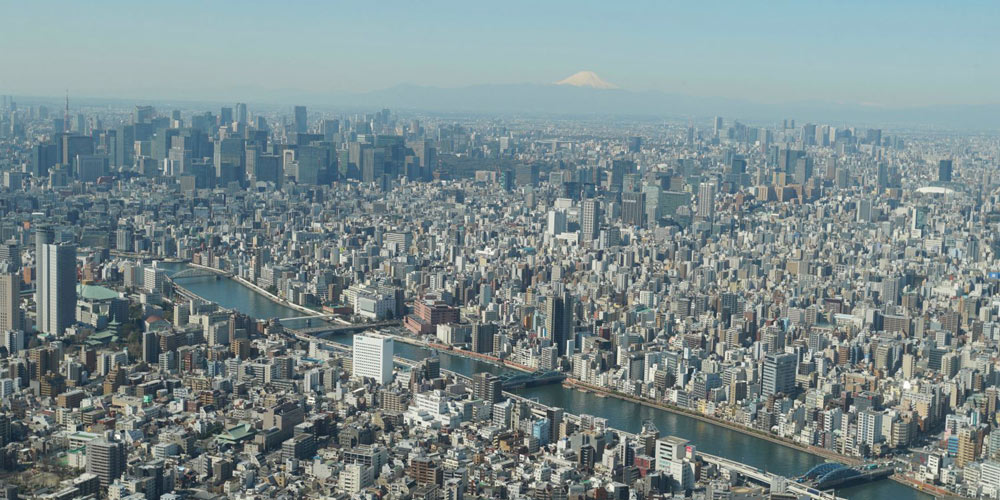
A view of the city from the top of Tokyo’s Skytree
Talk about bright lights, big city: Tokyo is a whirlwind of colors and flavors, sounds and scents. But this sprawling metropolis can be daunting for beginners. My advice: Plot out your days, neighborhood by neighborhood. You can easily see the city in as few as three days, but the more time you can spend, the better.
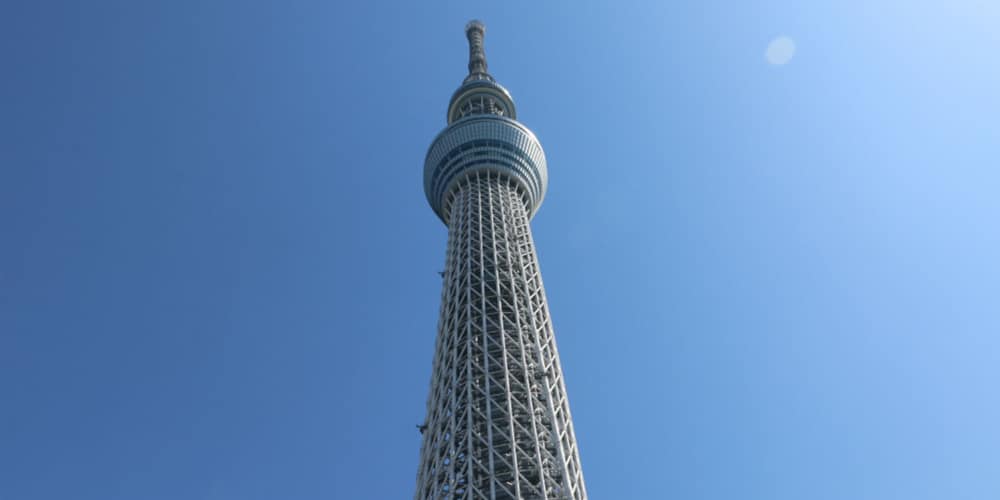
A view of Tokyo’s Skytree
Day One: The first stop on any Tokyo itinerary should be Skytree, the tallest tower in the world. The views reach all the way to Mount Fuji and will help give you a good overview of the city. Check out the glass floor on the 340th level and look down if you dare. Next, head to Solamachi, an entertainment center with tons of fascinating shops and restaurants that’s located on the lower levels of Skytree. Some of my daughter Lucy’s favorite spots included the Hello Kitty store with merchandise you can only find here; Toriton, a conveyor-belt sushi spot that is always packed; and the Sumida aquarium, with its eels, blowfish and penguins. You could easily spend a whole day exploring Skytree and Solamachi, but right across the river is Asakusa, Tokyo’s most historic district. It’s home to the ancient Sensoji shrine and Nakamise, a street lined with snack stands and souvenir shops.

The shark tank at Sumida Aquarium in Solamachi
Day Two: Start your day at Tsukiji, the legendary fish and food market. Take a tour with Arigato Japan, which will guide you to the best stalls and entertain kids with all the crazy food — from live shrimp to whale to snails. After, wander to Ginza, known for its department store food halls, kabuki theatre and high rises. Later in the day, make reservations for the Mori Digital Art Museum (aka Teamlab Borderless), which will take a few hours to explore. Trust me: You and your kids will be blown away by the magical digital art installations.
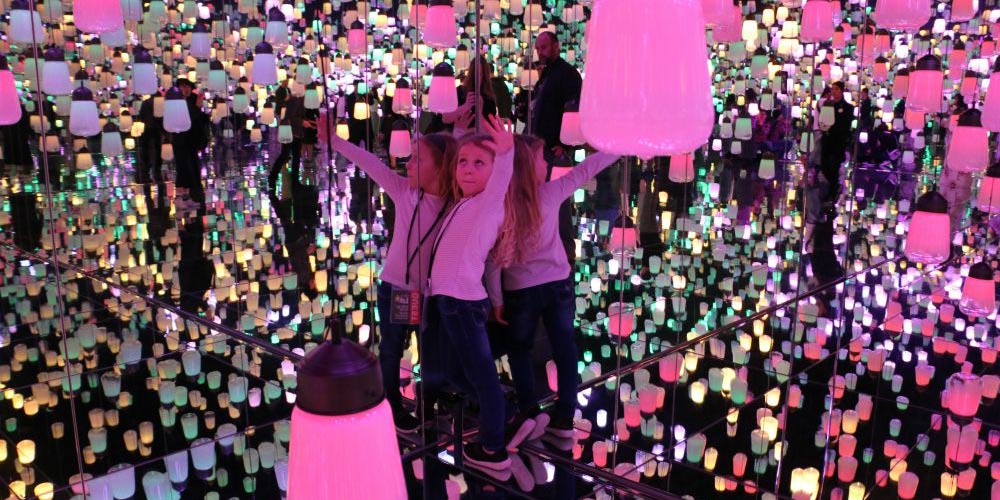
Mori Digital Art Museum
Day Three: Kids of all ages will go wild for Harajuku, which is ground zero for Tokyo’s youth culture. My family and I took Arigato Japan’s Crazy Kawaii food tour (kawaii means “cute” in Japanese), which gave a great introduction to the over-the-top food and culture in this too-cool-for-school neighborhood. Also, pay a visit to the wild and creepy Owl Café on Takeshita Street and don’t miss the stunning Meiji Shrine, nearby. If you have time, head to Shibuya to witness the famously crowded street crossing.
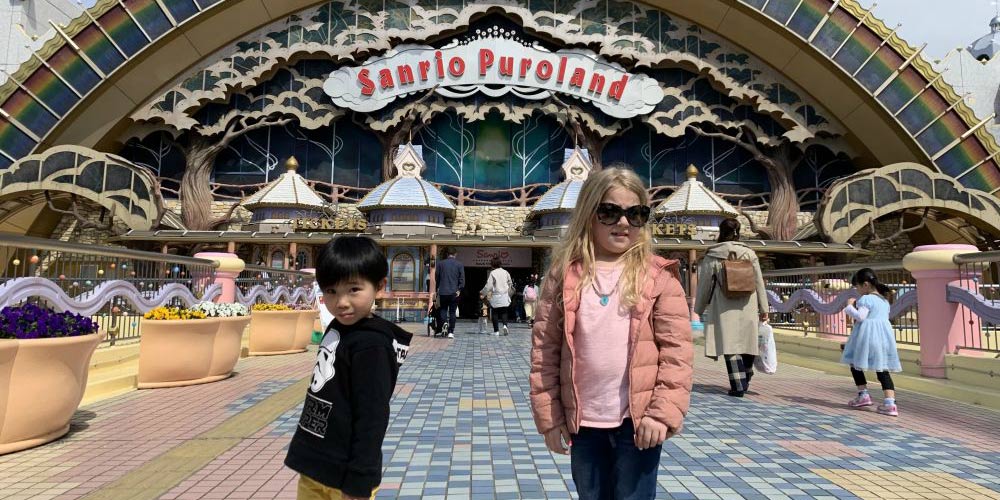
Sanrio Puroland, aka Hello Kitty Land
Day Four: Is your child a lover of Hello Kitty? Spend the day at Sanrio Puroland, a.k.a. Hello Kitty Land Tokyo, where Hello Kitty is the star of the show at a fanciful and fun indoor theme park that attracts over a million visitors a year. Located in the Tokyo suburb of Tama, Sanrio Puroland is just an hour by train from Shinjuku station.
Day Five: You’ve done the highlights. Now see what else you can squeeze in. Explore the stunning Imperial Palace East Gardens. Visit Shinjuku’s electronics superstores. Check out the views from the Park Hyatt Tokyo, which was featured in the movie Lost in Translation. Watch Sumo wrestling, if it’s happening while you’re in town. Take a river cruise in Nihonbashi. If you’re here during spring, have dinner along the Nakemeguro canal, which is famous for its beautiful cherry blossoms.

Tokyo’s Tobu Hotel Levant
Where to Stay
Want to see some of the most amazing views in the world — and not pay a fortune? Stay at the Tobu Hotel Levant, a well-priced find that overlooks Skytree tower and the skyline of Tokyo. Be sure to ask for one of the chic, renovated rooms. The breakfast buffet at Tobu Hotel Levant is staggeringly huge and good. A little more expensive, but worth every penny, is the Shiba Park Hotel, where kids can spin the huge globe in the lobby and make origami with the staff, who gave Lucy a kit when we checked in. The rooms are sleek and modern. If money is no object, there’s the Hoshinoya Tokyo, which is modeled after a traditional Japanese inn called a ryokan. You check your shoes when you arrive, change into a yukata, eat a multi-course dinner in your slippers and soak in an onsen bath fed by hot springs from deep under the ground.
Next up: Kyoto
Kyoto

A geisha in Kyoto
Don’t underestimate Kyoto. This historic city known for its temples, gardens and geishas has also become one of the most popular tourist spots on the planet. My recommendation: Hire a private guide like Bodhi Fishman, who showed me and my family around the city and arranged once-in-a-lifetime experiences like lessons from a master calligrapher. Another great resource is Chris Rowthorn, who can provide trip-planning and guiding services and runs the helpful site, Inside Kyoto. Two days should be enough to take in the major sites in Kyoto; three is even better.
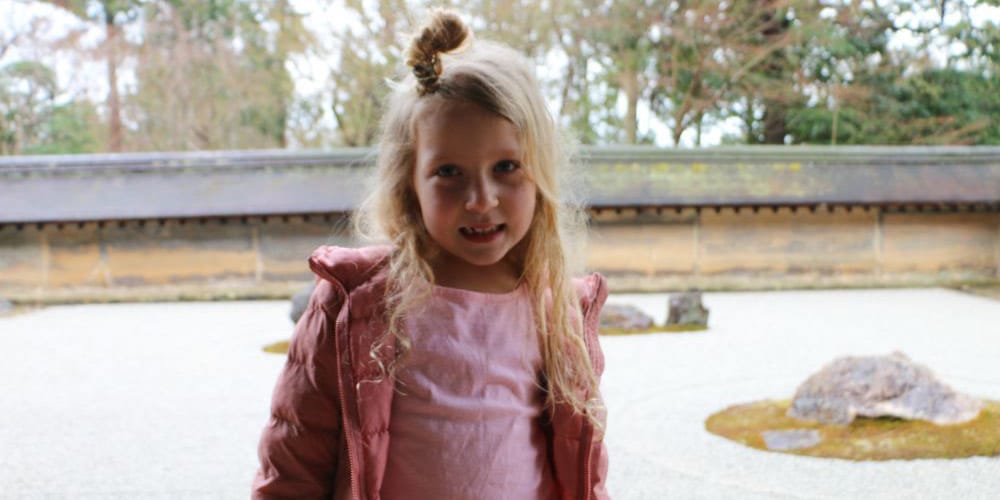
Kyoto’s Ryōan-ji Rock Garden
Day One: You can’t miss Fushimi-Inari-Taisha (aka the Fox Shrine), one of the most Instagrammed spots in the world, thanks to its endless pathways of bright orange gates. It’s open 24 hours and Fishman says it’s particularly memorable to go in the middle of the night (great if the kids have jet lag!). The street leading to the temple sells delicious snacks. Back in the center of Kyoto, spend time wandering around to the artisan shops. Another only-in-Kyoto experience: spotting geishas in the Gion when they are heading to their performances. A guide like Bodhi Fishman will show you exactly where to go and when.
Day Two: Ryōan-ji is an ancient and mystical garden with 15 rocks that float on a sea of stones. It’s mesmerizing. Beat the crowds and arrive right when it opens. In fact, a tip: For any of the temples in Kyoto, you want to get there first thing in the morning before the tour buses arrive. Next, head to the Kano River and walk up the steep mountain to Iwatayama, the monkey park. Visit the Bamboo Forest. Check out the Kinkaku-ji Temple (the “Golden Pavilion”).
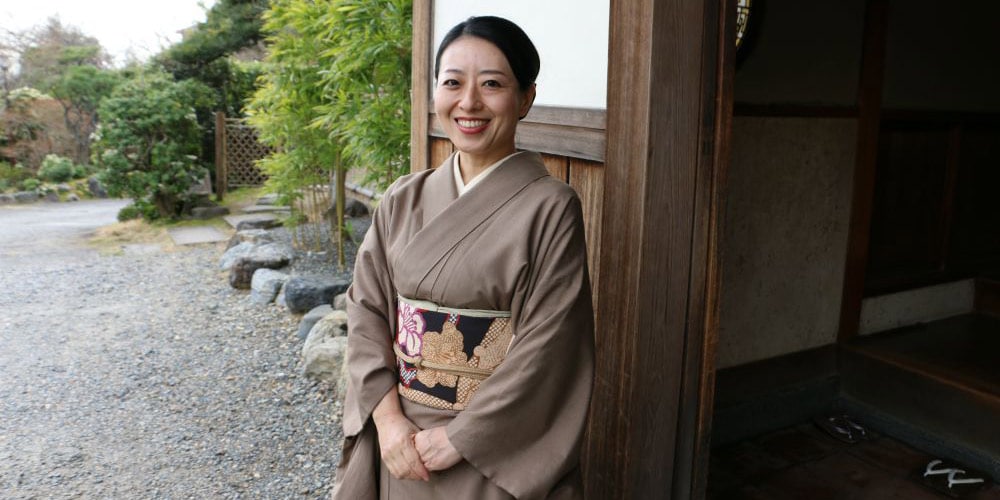
Kyoto’s Yoshida-Sanso ryokan
Where to Stay
A quintessential Kyoto experience is to stay in a traditional ryokan. Yoshida-Sanso is located in a former imperial villa built for a prince. It’s run by a woman and her mother who take care of you like you’re part of the family. In the center of Gion, the Yoshikawa ryokan has a wonderful tempura restaurant and a koi pond out back that kids will love.
Next up: Nikko
Nikko

Nikko’s historic Shinkyo Bridge
On a trip to Japan, it’s important to get away from the big urban centers and experience the country’s quiet, meditative side. On this trip, we decided to check out Nikko, which is famous for its temples and shrines, as well as its hot springs and waterfalls. But what really attracted us was a theme park called Edo Wonderland, which is Japan’s version of Colonial Williamsburg — only better. Nikko is a little less than two hours away from Tokyo via Tobu Railways and well worth the journey
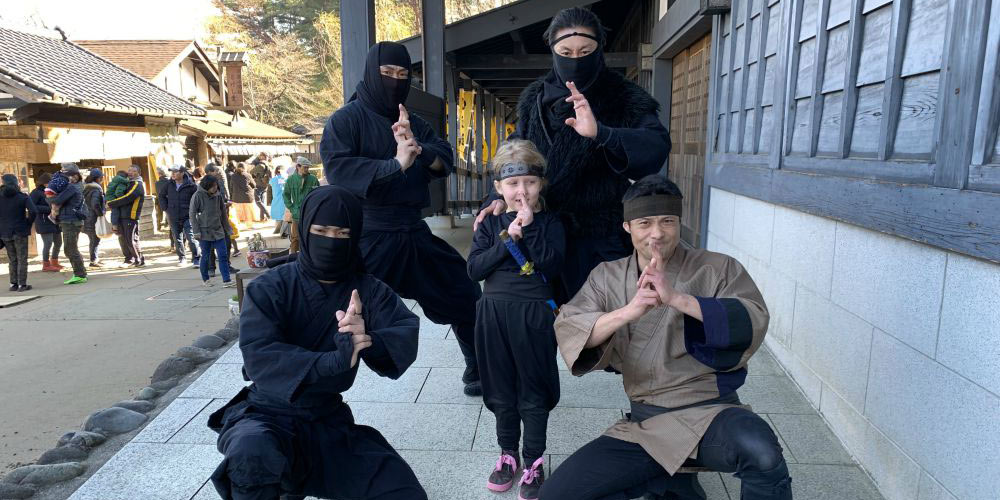
Ninja style at Nikko’s Edo Wonderland
Day One: First stop: Nikko-No-Sho, a restaurant and interactive cooking studio where families can learn to make soba noodles and eat them, too. Kids will love Edo Wonderland, where everyone in the family can dress up in Edo-style attire, from flowing princess robes to black ninja gear. The park is modeled after an ancient village from 17th century Japan, with houses where you can practice shuriken throwing, learn to play a shamisen (a musical instrument used by geishas), watch a ninja performance and more. There’s enough to spend two days here.
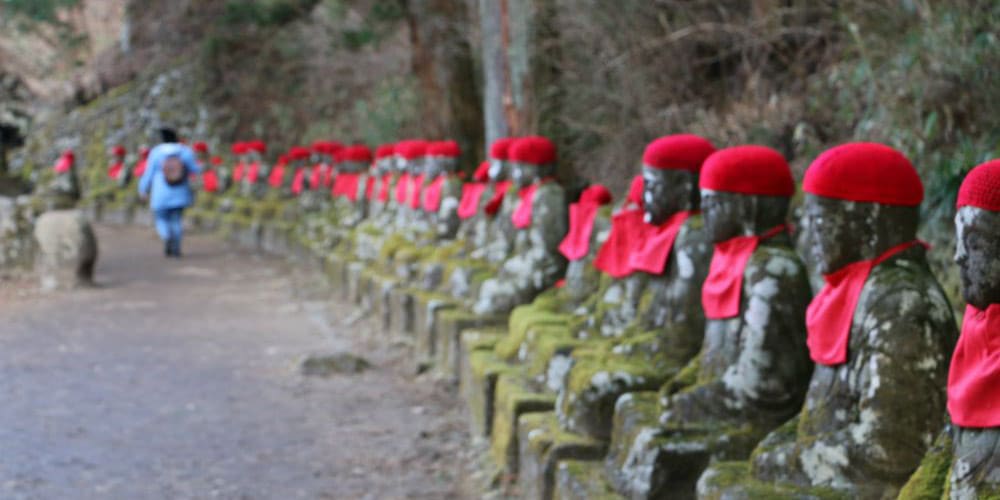
Along the Kanmagafuchi Abyss
Day Two: Today is the day to experience Nikko’s natural wonders like the Kanmagafuchi Abyss, a riverside walking trail; Kegon Falls, a massive set of waterfalls; and the stunningly beautiful Lake Chuzenji. And there’s nothing more amazing than touring Nikko’s renowned UNESCO World Heritage Sites, which include ornate and ancient shrines and temples. Kids will love seeing Toshogu shrine’s three monkeys (hear no evil, see no evil, speak no evil), as well as the famous Crying Dragon, a painting that mysteriously makes a noise on demand (it has to be witnessed to be believed). And don’t miss the pretty Shinkyo Bridge.

At the KAI Nikko
Where to Stay
A joy of coming to Nikko is being able to stay at the KAI Nikko, a ryokan set next to Lake Chuzenji with views of Mt. Nantaisan. Guests of all ages wander around in their yukata robes, have a traditional kaiseki dinner sitting on tatami mats, soak in a hot spring-fed onsen, have a traditional massage and watch dance performances. With its beautiful gardens and Zen-like rooms, it’s is like stepping into a painting.
By Laura Begley Bloom

